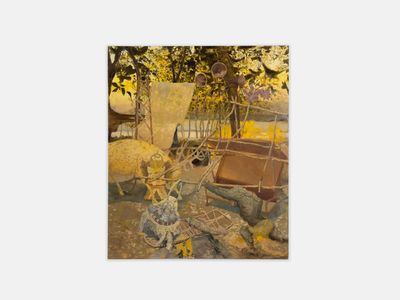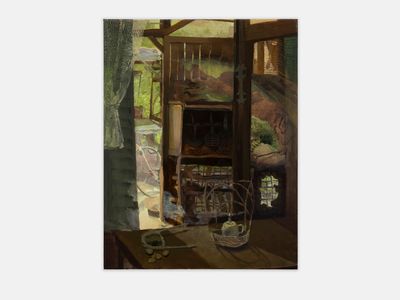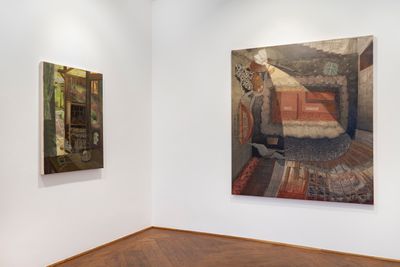
Painter Justin Rui Han Talks Plans at The Artist Room
Painter Justin Rui Han had just completed a BFA from Rhode Island School of Design when The Artist Room's Laurie Barron spotted his work at the degree show and invited him to participate in Eccentric Spaces, a group show at the London gallery in January 2023.
Justin brought Linguere's Courtyard (2022), an oil on canvas that referenced Hyenas, a 1992 film about a woman returning to her hometown in Senegal to propose a deal to the populace: her fortune in exchange for the death of her husband who abandoned her with their child. The gallery's footfall was taken by its clear descriptive qualities and painterly charm, and as such conversations about a solo exhibition with the gallery began.
Fast forward 12 months and a series of nine paintings have now arrived in London for his first solo exhibition Shatter Zones (22 February–23 March 2024) at the gallery in Soho.
Ocula invited Barron to speak with Han about his plans for the show, the artists that formed his thinking, and how this year could see him 'break out of the rectangle' into more sculptural works.
What are the key investigations that make up your practice?
Within the formal constraints of painting, I am testing how disparate forms might encounter others like or unlike themselves. The beings, objects, flora, and architecture in my recent work are decided by a narrative condition like a profession (fishing, mining, peddling goods) or a social institution (bathhouse, burial ground, storefront).
It's a way of anchoring the work so that the resulting image swirls around a central, fabulistic pretence. Composing images is a way for me to grasp at a feeling of community, and I do so by aggregating components from film stills, direct observation, and archival sources.
I imagine each painting as a space where the participants, still or animate, are stewards of distinct lands and memories. In some scenes, these actors engage in frivolous mischief, while in others they work out disagreements.
I want to conjure the feeling that arises out of intermingling across multiple genres of social difference, in someone's home or on the street, whether one experiences an ideological clash or an instant affinity with someone else's sensibility.
For me, the experience of being among others is most aptly summarised in ideas like camaraderie and intimacy, or conversely, indignation and shared dissent. Painting is an avenue for conveying that kind of social magic, while also delving into transnational histories.
What have you planned for your first solo show with The Artist Room?
There are nine paintings in this show. They're primarily oil on canvas, though some include earlier layers in acrylic or shapes blocked out with handmade paper. Each begins with a different trigger or provocation: a specific pigment or hue, a site depicted in a film, or a mere feeling (a vengeful atmosphere, vertigo, dust carried by wind) that a painting becomes an excuse to pursue.
Tell me about the title: Shatter Zones.
While seeking an analogy that would be apt for how I construct a painted space, I began reading anthropologist James C. Scott's book The Art of Not Being Governed (2009), which is told as an 'anarchist history' of the highlands of Southeast Asia and southern China.
Scott is interested in the choice communities make to remain stateless, to be fugitives from empire. Before the book, I was interested in how painting might address or hold a mirror up to such ideas about social reorganisation. I build assemblies in paintings as an oblique way of exploring utopian ideas, and texts like this are a kind of conceptual ammunition.
The show title is aspirational and I think of each painting as its own porous 'shatter zone'. Each is provisionally mapped out, and the elements relate with some volatility to one another; the objects and beings alike are passing through, each with their desires and motivations.
I'm really interested in how your work brings different, carefully sourced, phenomena together: histories, geographies, and forms of culture. How do you plan each work?
The work is meant to replicate the feeling of exposure to unfamiliar histories—the objects and beings are a prism through which to realise that feeling. That is to say that though not everyone is responsible for knowing the date of a coup in Iran or Chile, or about a 19th-century rural revolt in Vietnam, I choose to dwell in the far reaches of what the Western pathology (borrowing Howardena Pindell's words) considers unknowable or indigestible.
To me, wonder and awe are catalysts for taking collective responsibility and refusing interminable violence. Constructing images is how I open viewers to that possibility. The dispersed nature of their presentation reflects how I came to know each thing, whether a bough on a frankincense tree, an irrigation diagram, or an animal imagined to hold messianic power.
Physically, the work comes together through drawings (tonal or colour), colour studies, large packets of printed images, and reflections from studio visitors. I take time to give each work clear descriptive qualities before I put down any pigment, then improvise as I encounter things that might become pertinent.
Sometimes I see what I'm imagining by coincidence, as happened recently when I was in Hong Kong and saw the terraced cemeteries that inspired Attendant and Desecrators (2023).
Research is a vital part of your practice. References in your show are wide-ranging: Japanese folklore; the automotive manufacturer Citroën; and Djibril Diop Mambéty's revenge drama Hyenas are just a few examples. How would you describe the process behind showing these fascinating references to visitors in a different context?
The dynamic I have with my source material alternates between admiring and oppositional. I like to implicate stories that provoke in me a kind of disgust at human hubris or sensorial aversion, things like Citroën's La Croisière Jaune (Yellow Cruise), an expedition from Beirut to Beijing that began in 1931.
I came across this bizarre marketing campaign by chance, while looking at 1920s archival footage of the Swedish explorer Sven Hedin's time in Xinjiang and Tibet, guided by my paternal great-grandfather Xu Xusheng.
I look back on this ancestor of mine whom I never met with awe and disbelief: awe that our interests have coincided in this way (I also studied history alongside archaeology), and difficulty stomaching that he'd help this foreign explorer plunder gratuitous quantities of Silk Road heritage.
I respond to a lot of other historical material with a similar fascinated ambivalence. Risk and Sanctuary (2023) nods to the printmaking of Kobayashi Kiyochika, whose later prints, during the Sino-Japanese and Russo-Japanese Wars, functioned as imperial propaganda, proud endorsements of violent campaigns across greater Asia. I cite and react to film or literary works when they carry a pathos that signals a wider expanse of historical burdens and urgencies.
Filmmakers like Mambéty and Youssef Chahine have been transformative for me in that they connect their aesthetic sensibilities to an oppositional stance (for them, against neocolonialism and predatory globalisation). But the impacts are first delivered through activation of the senses, and then a sensitive humanism. I hope that the paintings unfold in a similar way.
Your paintings evoke a certain timelessness—could you discuss this particularly universal feeling of absence, of untold stories?
Situating myself outside of time and geography is a creative permission, allowing me to implicate various forms as appropriate to tone and mood. I neither hedge to the present nor silo my work within the deep past. When my interests cut across time, I can work with images that tap into mediaeval interconnectedness as much as contemporary global capital.
I picked this attitude up while studying history and literature comparatively; I converted this academic permission to a studio one, in which I am not afraid to look at things synchronically, to imagine their confluence.
Distorting time is how I prod at what should not be forgotten, invoking our many responsibilities to the living and dead. If there is a feeling of mourning in my work, it has to do with our civic duty to remember. Memory gives one clarity and courage to intervene when an atrocity is underway.
I often think of this in terms of infrastructure projects, such as working class and immigrant communities destroyed by the building of highways in the U.S., or the Three Gorges Dam in China (well illustrated in the films of Jia Zhangke).
Today, many of my artist peers are mobilising memory and storytelling in opposition to the genocidal Israeli campaigns in Gaza—I aspire to this kind of clarity of pictorial purpose.
Could you talk about the role lighting plays in your work, whether the spaces are lit brightly by day or deep in darkness? And the perspective manipulations you use? Often, viewers watch from above, or the angles and planes are skewed, creating a disorientating effect.
In my manipulation of spaces, I like to weave between the enclosures of genre. The scenes variously sample from categories like domestic interior, town square, vast agrarian landscape, or the grim severity of a construction site. The plays on perspective (in paintings like Tsuchigumo's Playthings and Attendant and Desecrators [both 2023]) are informed by artists like Mernet Larsen and Roger Brown, both of whom grapple with graphic flatness and maintain a sceptical distance from the illusionistic.
I want the paintings to permit accidental stylistic intrusions, which to me seem appropriate to the dizzying multiplicity of what they include. I made multiple drawings for these compositions, looking for viewpoints that would either gently or more dramatically bewilder.
Light is what lends space dynamism, whether its source is natural, oil-fed, or fluorescent. In some of the paintings, the light sources are rendered naturalistically, as initially observed. In others, I imagine light without a rendered source, which is an invitation to examine that skin of paint. Light, like time, is a permission by which I can assert that the moon, as seen from a riverbank in Vermont, should cast a shadow that lands in Manila.
Which painting movements and artists have been foundational in forming your thinking?
At this moment, I'm thinking often of Miyoko Ito, Roger Brown, and Evelyn Statsinger, who worked in my hometown of Chicago; modernists Yasuo Kuniyoshi and Marsden Hartley; the industrial scenes of Charles Sheeler; and finally, Charles Garabedian and Mary Lovelace O'Neal.
While working on the paintings for The Artist Room, I often looked at paintings by Chie Fueki and Timothy Lai. Contemporary artists who I can imagine informing my future work include Candice Lin, Suneil Sanzgiri, and An-My Lê.
What's next?
I'm imagining some new work that will involve textiles and reeds, among other materials, and break out of the rectangle. I've been conceiving of these works even while finishing the London show, so I'm very eager to realise them and to explore sculptural strategies that are akin to how I build a painting. It feels like it'll be something of a homecoming to work in other media that have been my companions as long as oil and acrylic have.
Main image: Justin Rui Han, Peddlers' Feud (A Breath of Wind Merits Release) (2023). Oil on canvas. 121.9 x 152.4 cm. © Justin Rui Han. Courtesy The Artist Room, London. Photo: Damian Griffiths.

















